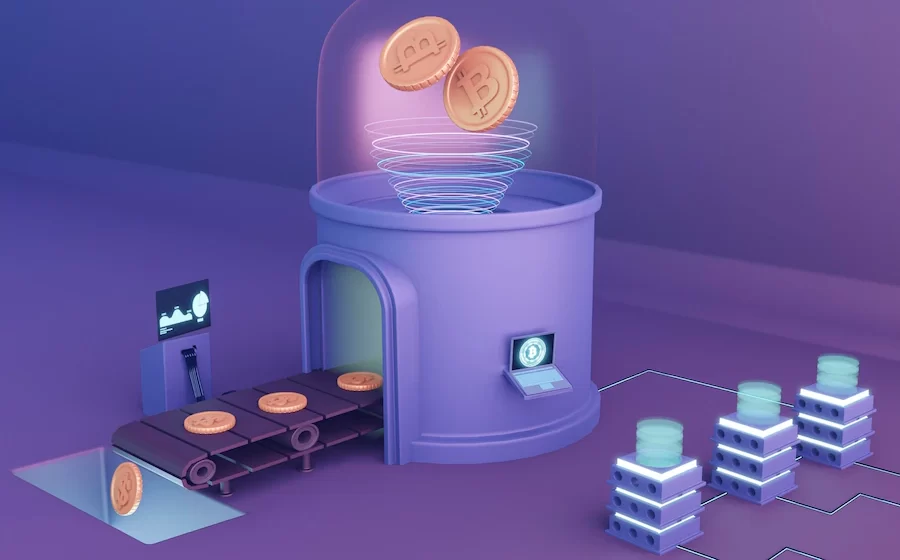Bitcoin mining and the Blockchain technology
- 1 Understanding Blockchain Technology
- 2 How Blockchain Works
- 3 The Role of Bitcoin Mining
- 4 Significance and Impact of Bitcoin Mining and Blockchain
- 4.1 Decentralization and Security
- 4.2 Transparency and Immutability
- 4.3 Economic Impact
- 4.4 Challenges and Criticisms
- 5 Future of Bitcoin Mining and Blockchain
- 6 Conclusion
Bitcoin, the first and most well-known cryptocurrency, has revolutionized the financial world since its inception in 2009 by an anonymous entity known as Satoshi Nakamoto. At the core of Bitcoin’s functionality are two groundbreaking technologies: Bitcoin mining and blockchain technology. This article delves into these concepts, exploring their mechanisms, significance, and impact on the digital economy.
Understanding Blockchain Technology
What is Blockchain?
Blockchain is a decentralized digital ledger technology that records transactions across multiple computers so that the registered transactions cannot be altered retroactively. This ensures transparency and security without the need for a central authority.
A blockchain consists of a series of blocks containing a list of transactions. When a block is completed, it is added to the chain, creating a continuous and unchangeable record of all transactions.
How Blockchain Works
- Transaction Initiation: A user initiates a transaction, which is then broadcast to a network of computers known as nodes.
- Validation: These nodes validate the transaction using consensus algorithms. In the case of Bitcoin, this is primarily the Proof of Work (PoW) algorithm.
- Block Creation: Once validated, the transaction is included in a block. Miners then compete to solve a complex mathematical problem to add this block to the blockchain.
- Addition to the Blockchain: The first miner to solve the problem broadcasts the block to the network. Other nodes verify the solution; the block is added to the blockchain if it is valid.
- Confirmation: The transaction is immutable, ensuring a secure and transparent record.
The Role of Bitcoin Mining
What is Bitcoin Mining?
Bitcoin mining is the process by which new bitcoins are introduced into circulation and is also a critical component of the maintenance and development of the blockchain ledger. It involves solving computationally difficult puzzles to validate transactions and add them to the blockchain.
How Bitcoin Mining Works
- Transaction Pool: Transactions made by Bitcoin users are bundled into a block by miners.
- Proof of Work: Miners solve a complex computational problem based on the SHA-256 hash algorithm, which requires significant processing power.
- Block Addition: The first miner to solve the problem gets to add the block to the blockchain and is rewarded with newly created bitcoins (block reward) and transaction fees.
- Difficulty Adjustment: The problem’s difficulty adjusts approximately every two weeks to ensure that blocks are added roughly every ten minutes.
Mining Rewards
Initially, the reward for mining a block was 50 bitcoins. However, this reward is halved approximately every four years in an event known as “halving.” The reward stands at 6.25 bitcoins per block, highlighting Bitcoin’s deflationary nature.
Significance and Impact of Bitcoin Mining and Blockchain
Decentralization and Security
One of the key benefits of blockchain technology is its decentralization. Unlike traditional banking systems, which rely on a central authority, blockchain operates on a peer-to-peer network. This reduces the risk of centralized points of failure and increases security.
Transparency and Immutability
Blockchain’s transparent nature allows anyone to view the entire transaction history. Once a transaction is recorded on the blockchain, altering it is nearly impossible, ensuring data integrity and trust.
Economic Impact
Bitcoin mining has led to the creation of a new industry with significant economic implications. It has given rise to mining farms and companies specializing in mining equipment and has even influenced the energy markets due to the high electricity consumption of mining operations.
Challenges and Criticisms
Despite its advantages, Bitcoin mining faces several challenges:
- Energy Consumption: Bitcoin mining is energy-intensive, raising environmental concerns. Efforts are being made to develop more energy-efficient mining methods.
- Centralization Risk: Although blockchain is decentralized, mining can become centralized if a few entities control a significant portion of the network’s hashing power.
- Regulatory Issues: The rise of Bitcoin and other cryptocurrencies has prompted discussions about regulation. Different countries have varied approaches, ranging from supportive to outright bans.
Future of Bitcoin Mining and Blockchain
Technological Advancements
Ongoing research and development aim to address the challenges of Bitcoin mining and blockchain technology. Innovations like the Lightning Network seek to improve transaction speeds and reduce costs. New consensus algorithms like Proof of Stake (PoS) are also being explored to reduce energy consumption.
Adoption and Integration
Blockchain technology is being adopted across various sectors beyond finance, including supply chain management, healthcare, and voting systems. Its potential to improve efficiency, transparency, and security is recognized globally.
Regulatory Developments
As the technology matures, so does the regulatory landscape. Clear and balanced regulations can foster innovation while protecting consumers and ensuring financial stability.
Conclusion
Bitcoin mining and blockchain technology represent a revolutionary shift in conducting and recording transactions. While challenges remain, the potential benefits of these technologies are vast. They promise a future where financial systems are more transparent, secure, and efficient, impacting not just the world of finance but numerous other sectors. As advancements continue, the integration and adoption of blockchain technology are likely to expand, driving further innovation and transformation.

















